Got a nasty surprise when I decided to go through one of my storage tubs in a storage shed. The 40+ years old sheds decided to start leaking this past Winter during the snow melt. Still making scary discoveries even after months of clean-up.
Got a nasty surprise when I decided to go through one of my storage tubs in a storage shed. The 40+ years old sheds decided to start leaking this past Winter during the snow melt. Still making scary discoveries even after months of clean-up.
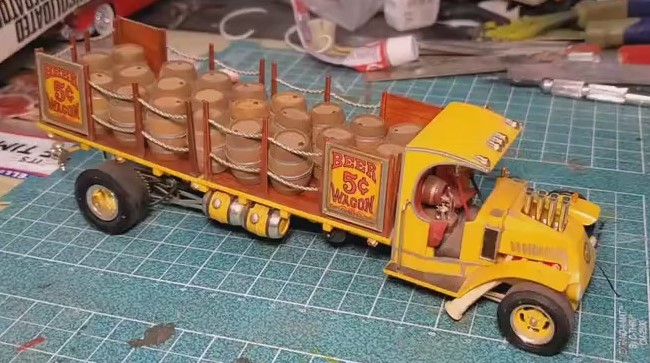
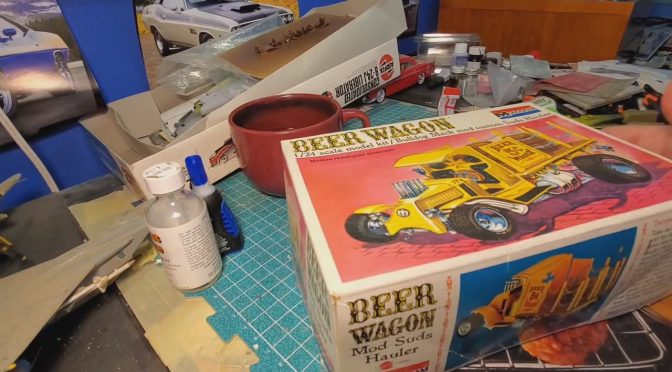
Can I make the 01DEC2023 build deadline?
Part 2: 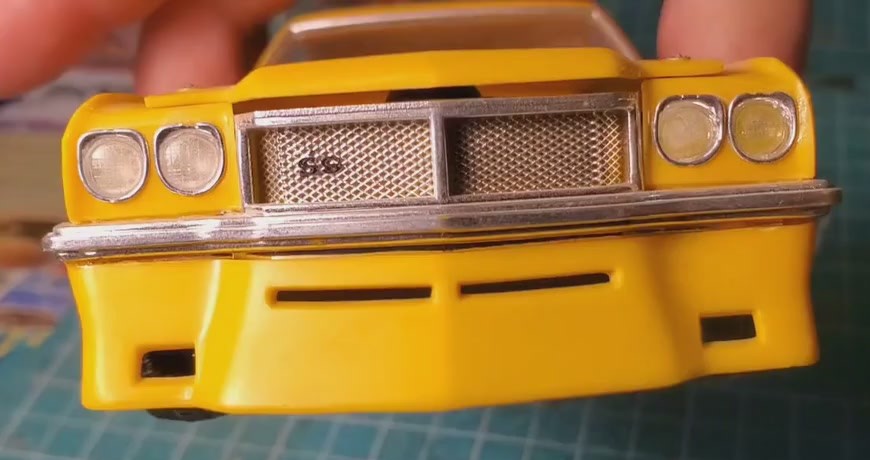 1970 CHEVY MALIBU, REVELL-MONOGRAM MERGER, WAS IT WORTH IT?
1970 CHEVY MALIBU, REVELL-MONOGRAM MERGER, WAS IT WORTH IT?
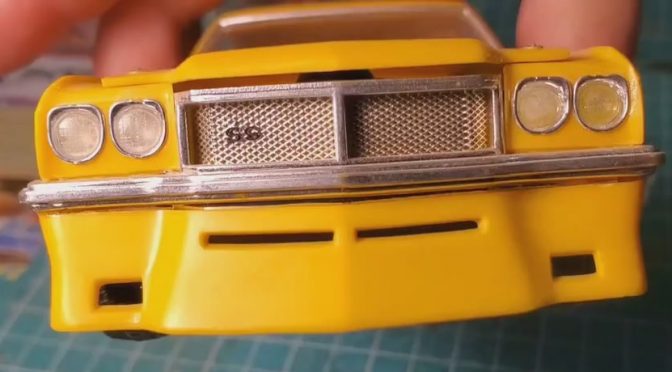
I continue my laborious ramblings about why the one time issued Monogram 1/24 scale 1970 Chevy Malibu is so significant to me.
How did I end up in Idaho, and is ‘following the jobs’ worth it?
Part 1: 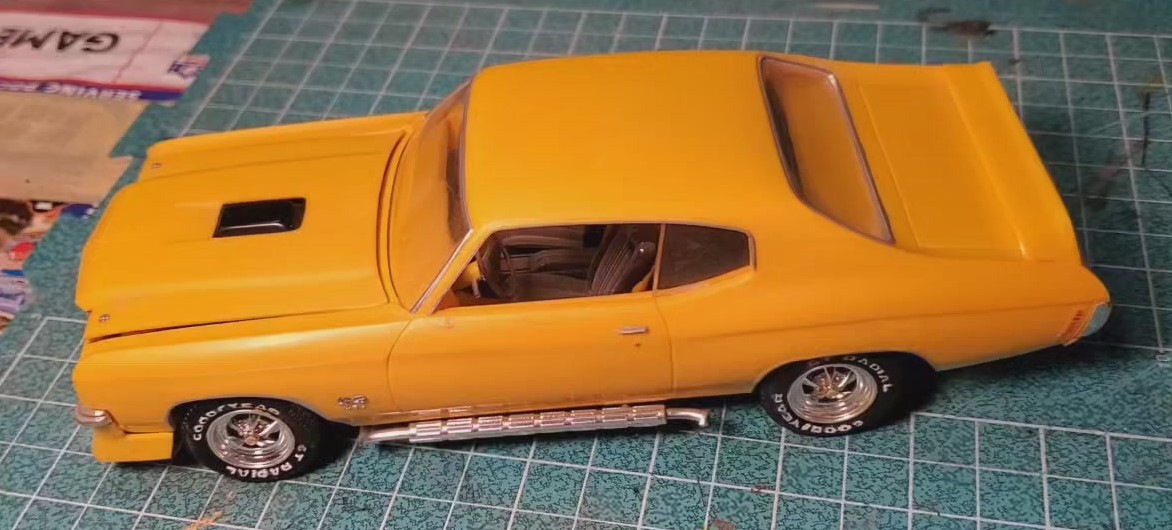 1970 CHEVY MALIBU, MY OLDEST SURVIVING CAR KIT & WHY IT’S SPECIAL TO ME
1970 CHEVY MALIBU, MY OLDEST SURVIVING CAR KIT & WHY IT’S SPECIAL TO ME
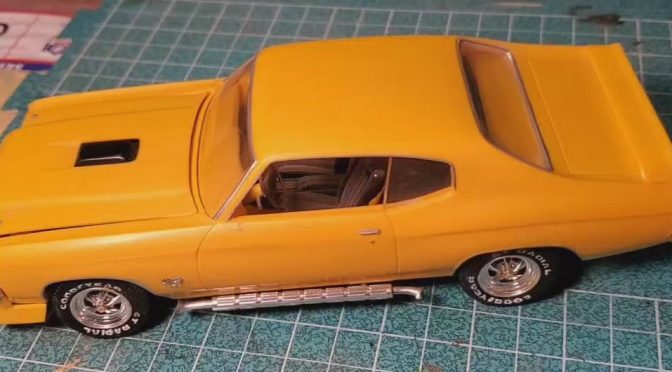
In 1982, I built this 1/24 Monogram kit as a reward for myself, for legally graduating high school at the age of 16 and being able to join the military at the age of 17, despite the fact my parents, and high school principal, said it couldn’t be done.
Kit Bashing: WHERE IS BLACKBIRD NASA 831? AND THE PROBLEMS WITH THE OLD TESTORS KIT.
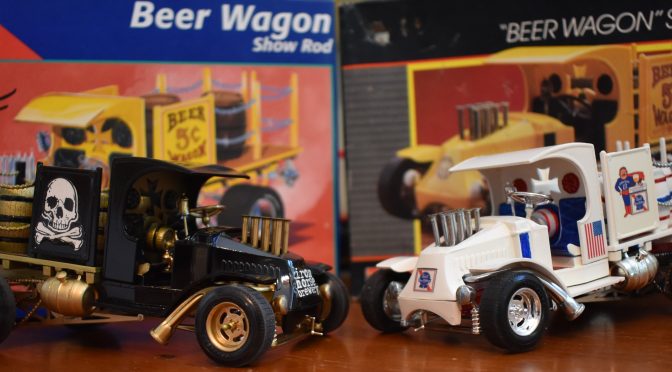
The classic Tom Daniel’s Monogram Beer Wagon (also issued as a Cola Wagon under the Revell-Monogram brand) was first issued in 1967. Apparently, it was last issued in 2016.
I built two Monogram Beer Wagons as xmas gifts for two guys who love their specific brands of beer; Pabst and Iron Horse Brewery’s Irish Death.
I used aftermarket Pabst decals meant for a 1970s gasser/drag racer. Alcohol based chrome paint was used on the headers, works good but is expensive.
The markings for the Irish Death were cut from Iron Horse Brewery’s 36 square-root package, thinned down and pasted with clear setting glue. Then I covered with lots of clear paint.
I tried using different brands of gold spray paints, all claiming to look like gold chrome. None of them lived up to their promise.
Video, the real 1:1 scale Beer Wagon:
Notice that the front axle doesn’t sit properly on both kits.
These old kits have a lot of fragile parts. Besides the plastic chains being prone to breakage, the rear light posts also like to break. On the Pabst Wagon I had to make new posts out of skinny plastic sprues. I drilled holes in the chassis to fix them in place, they turned out to be sturdier.
The kool thing about these old kits is that they’re great starting points for kool kustoms.
VEHICLE I-D with kit review: MODEL T & WHITE MOTOR WARRIORS
DEUTSCHLAND ÜBER ALLES!: REVELL USA IS DEAD, LONG LIVE REVELL GERMANY!
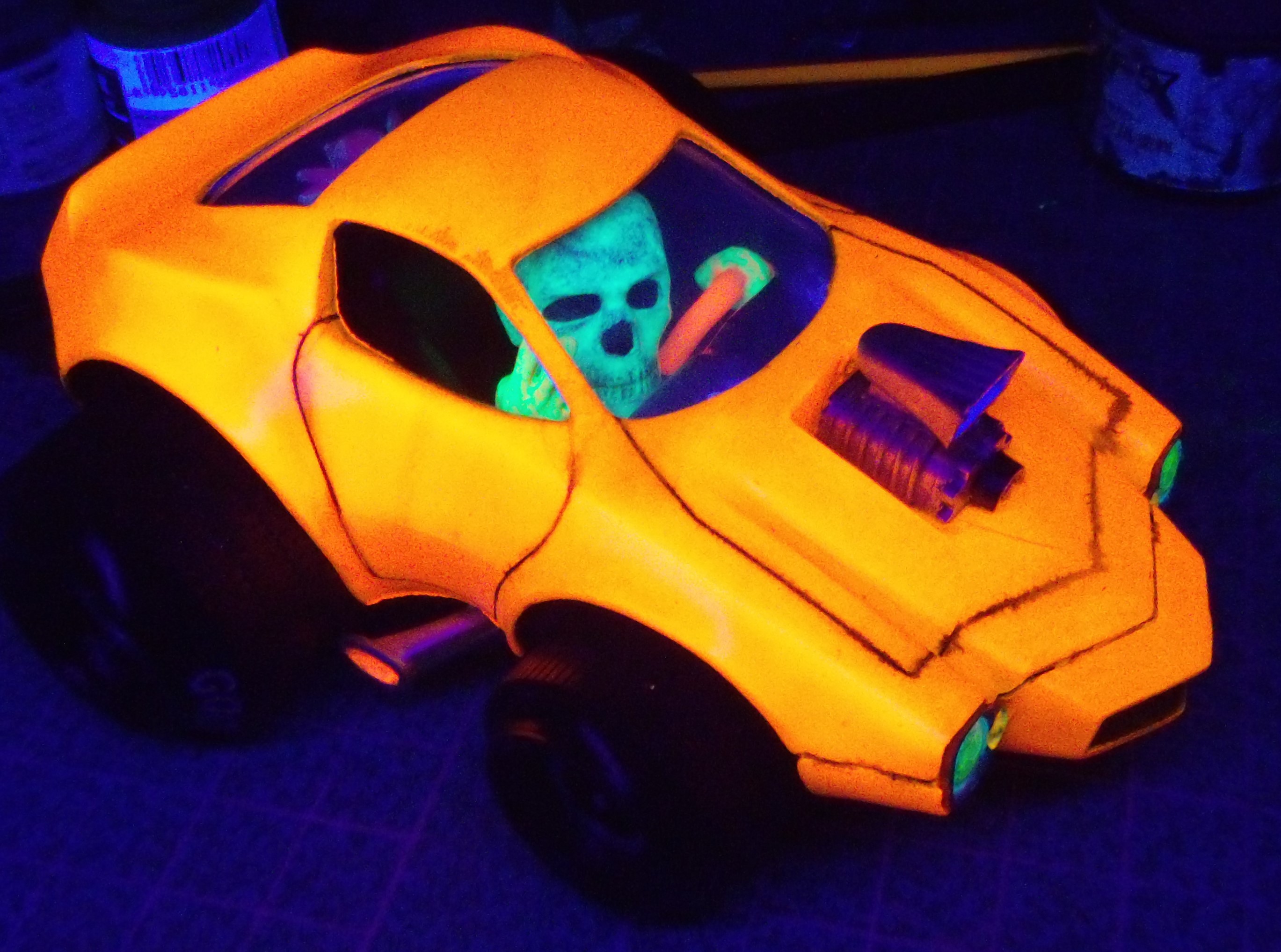 BLACKLIGHT REVELL DEAL’S WHEELS
BLACKLIGHT REVELL DEAL’S WHEELS
REVELL 1937 FORD PICKUP OR WHY MODEL ASSEMBLY INSTRUCTIONS CAN BE WRONG!
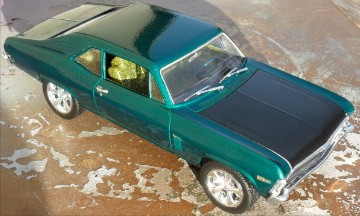
The hood got a clear coat of Plaid acrylic matte. The inner lip of the front fender wells had to be sanded slightly thinner so the Bullet Mustang tires would fit inside. I think the problem was caused by the way I mounted the disc breaks on the front suspension.
MORE PROOF INSTRUCTIONS ARE WRONG:
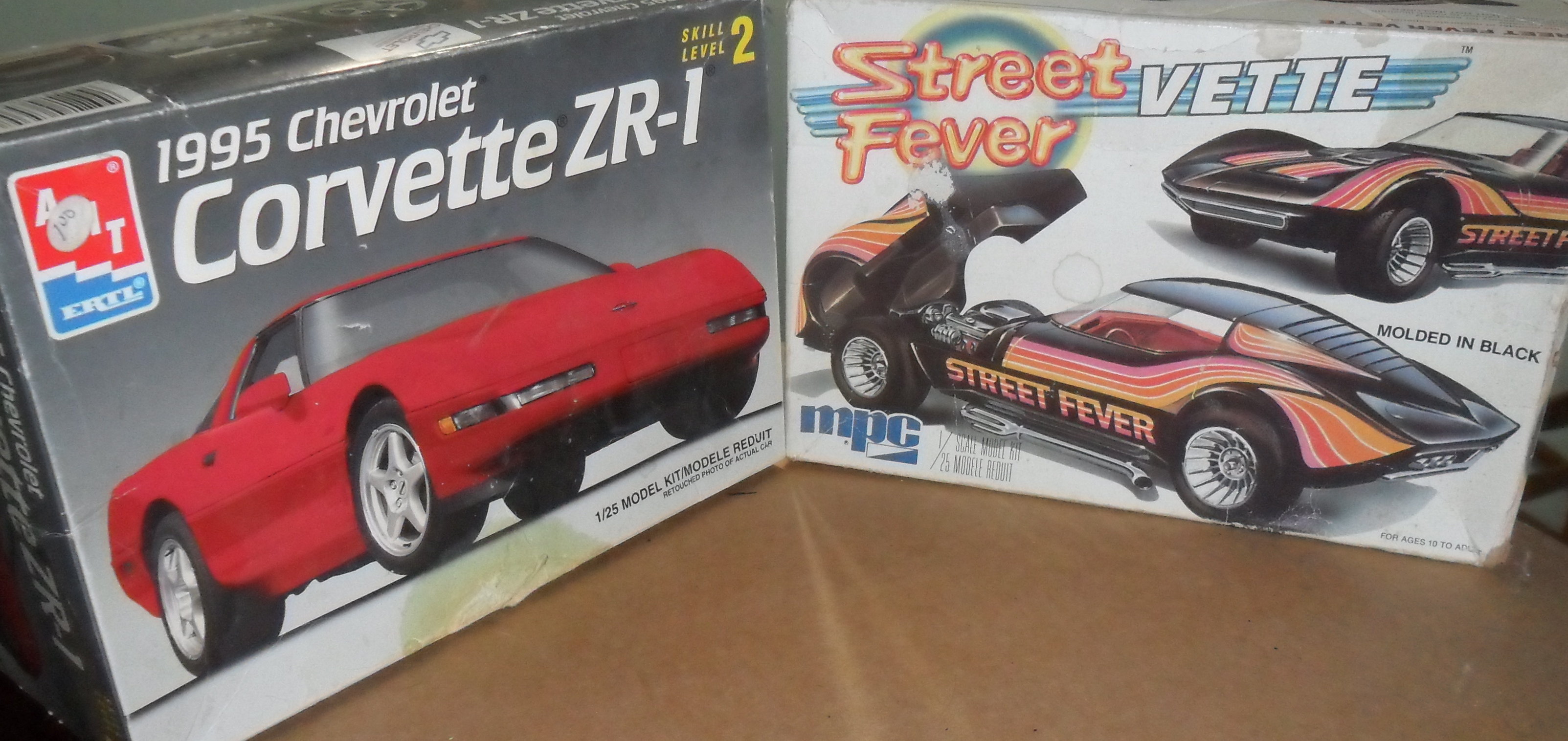
An old MPC custom Corvette and an AMT 1995 Corvette, missing parts, broken or unusable parts, combined to make a unique kit.
SALVAGING TWO DIFFERENT JUNK KITS INTO ONE UNIQUE CORVETTE
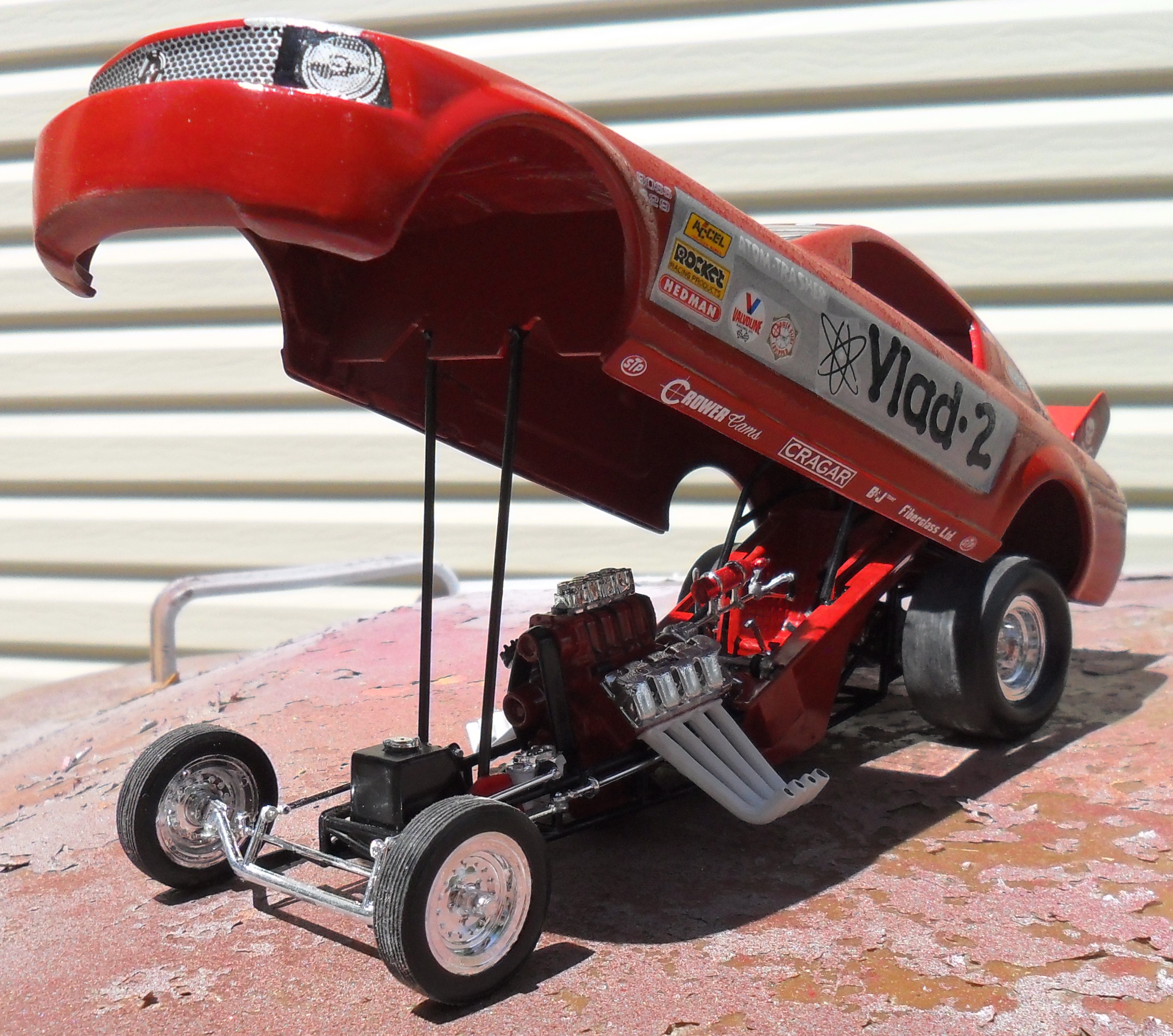
Open wide! In hindsight I should have used a wider/stronger chassis as the modified 2006 Mustang body is very heavy.
2006 Revell-Monogram MUSTANG FUNNY CAR DRAGSTER conversion
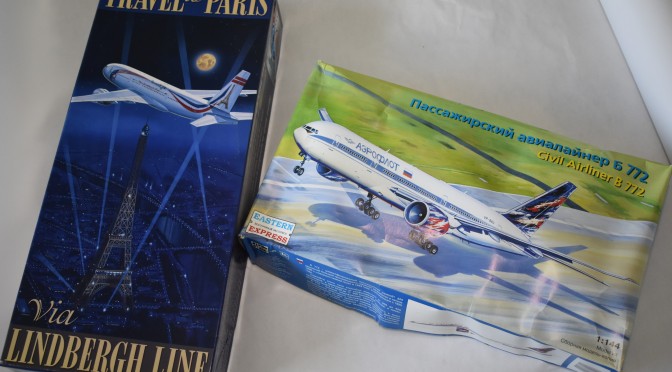
I’ve been able to get some 1:144 scale Boeing 777-200s (United Nations-International Civil Aviation Organization B772) for cheap; some Minicraft kits (made in China) being offered in an ‘as is’ grab bag sale (turned out they were complete, but one had a broken fuselage), and a two-for-one sale that got me Eastern Express issues (made in Russia) in both the -200 and -300 versions.
My biggest complaint about airliner kits is how much they cost versus what you get, that’s why I buy them only when I see them offered at great discount (and It’s really amazing that aftermarket decals can cost more than the kit, depending on the manufacturer). Airliner kits are basic, and even the nicer Revell Germany kits have fit problems. While the Minicraft airliners have fit problems the Eastern Express kits take the cake.
The Eastern Express Group kit requires a lot of pre-assembly sanding down of parts due to the amount of flash and other problems. You must dry fit the parts in order to avoid nasty surprises, such as the lower wing trailing edge needs to be thinned down to size in order to fit, however, the trailing edge of the flaps/ailerons are molded as part of the upper wing, giving a nice sharp trailing edge. The Minicraft Model Kits’ wings have blunt trailing edges, you’d have to spend time thinning down both wing halves to get a sharp trailing edge. The wings of the Eastern Express and Minicraft kits are very close in shape, size and detailing. Eastern Express has no mounting points to attach the wing to the fuselage, you’ll have to make your own spar. Minicraft uses interlocking fingers, apparently their engineers thought it was a good idea but the fingers actually interfere with getting a tight fit against the fuselage, they have to be thinned down or removed.
The Eastern Express fuselage is in three sections, allowing for different length mid-sections to model the -200 or -300 (you only get the sections described on the box). I lined up the competing kits’ fuselages starting at the tail end, the vertical tail tip on the Eastern Express is more angled, the overall diameter and length of the Minicraft kit’s fuselage is larger. The Eastern Express nose section is smaller than the Minicraft kit, but it looks more Boeing-like to me.
The horizontal tails/elevators look similar in shape and detail, but Minicraft’s are noticeably larger.
While the Eastern Express fuselage is smaller than Minicraft’s the opposite is true for the turbine nacelles. I’m considering swapping the very large Eastern Express nacelles with the Minicraft nacelles, the size difference is painfully noticeable when you compare the diameter of the intake lips. Minicraft’s nacelles will need just a little work to fit them onto the Eastern Express wings, but the Eastern Express nacelle pylons will need to be thinned down to fit into the Minicraft slots.
Here’s some pictorial evidence, which you can see more of the image by clicking on it:
I didn’t mention landing gear, most airliner kits do a bad job of representing them anyway (example; the Minicraft’s doors don’t come close to matching the wheel well openings, as if they were meant for a different aircraft), plus I normally build airliners wheels up and condemn them to eternal flight by hanging from the ceiling.
Update, December 2022: 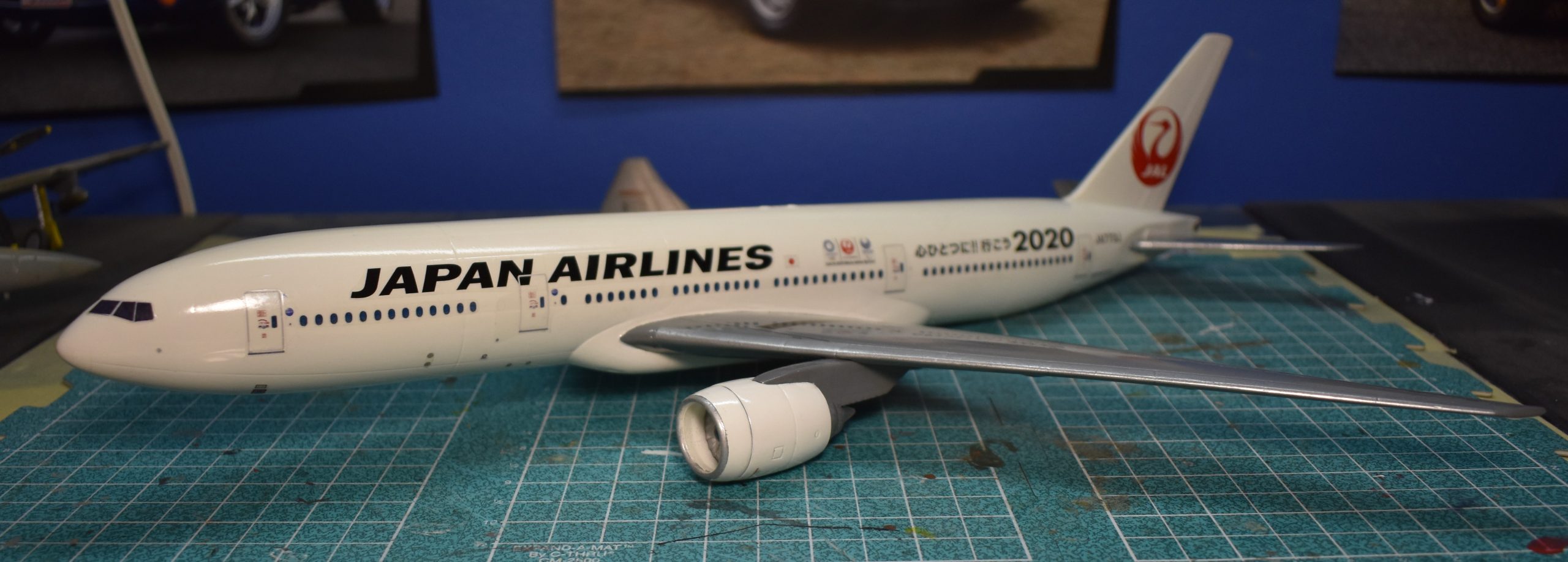 I finally finished building the Minicraft Boeing 777. I marked it with aftermarket decals for the 2020 Tokyo Olympics.
I finally finished building the Minicraft Boeing 777. I marked it with aftermarket decals for the 2020 Tokyo Olympics.
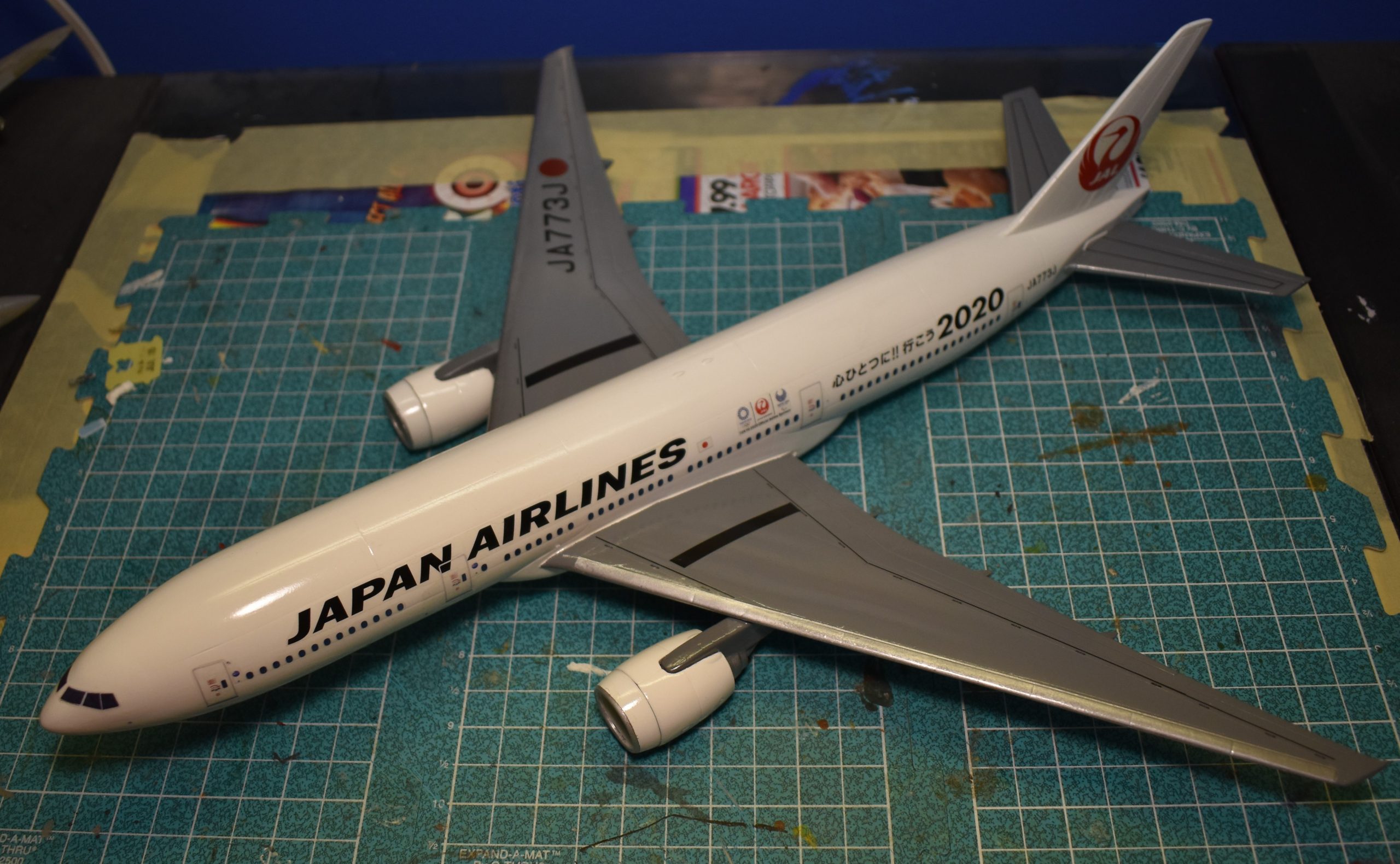
The aftermarket decals look good from a distance, up-close you can see how thick they are. I had to remove a couple of the smaller markings, because they curled-up and refused to lay down, no matter how much clear I coated them with.
It was going to be a gift for the couple who had spent big money reserving airline tickets, hotels and tickets to various Olympic venues.
Of course, due to The Pandemic hyperbole, first the Japanese government delayed the games by a full year, then banned foreigners from coming into Japan altogether! The highly disappointed couple did get their money refunded, and this year they finally get their very own 777 Tokyo Olympics airliner.
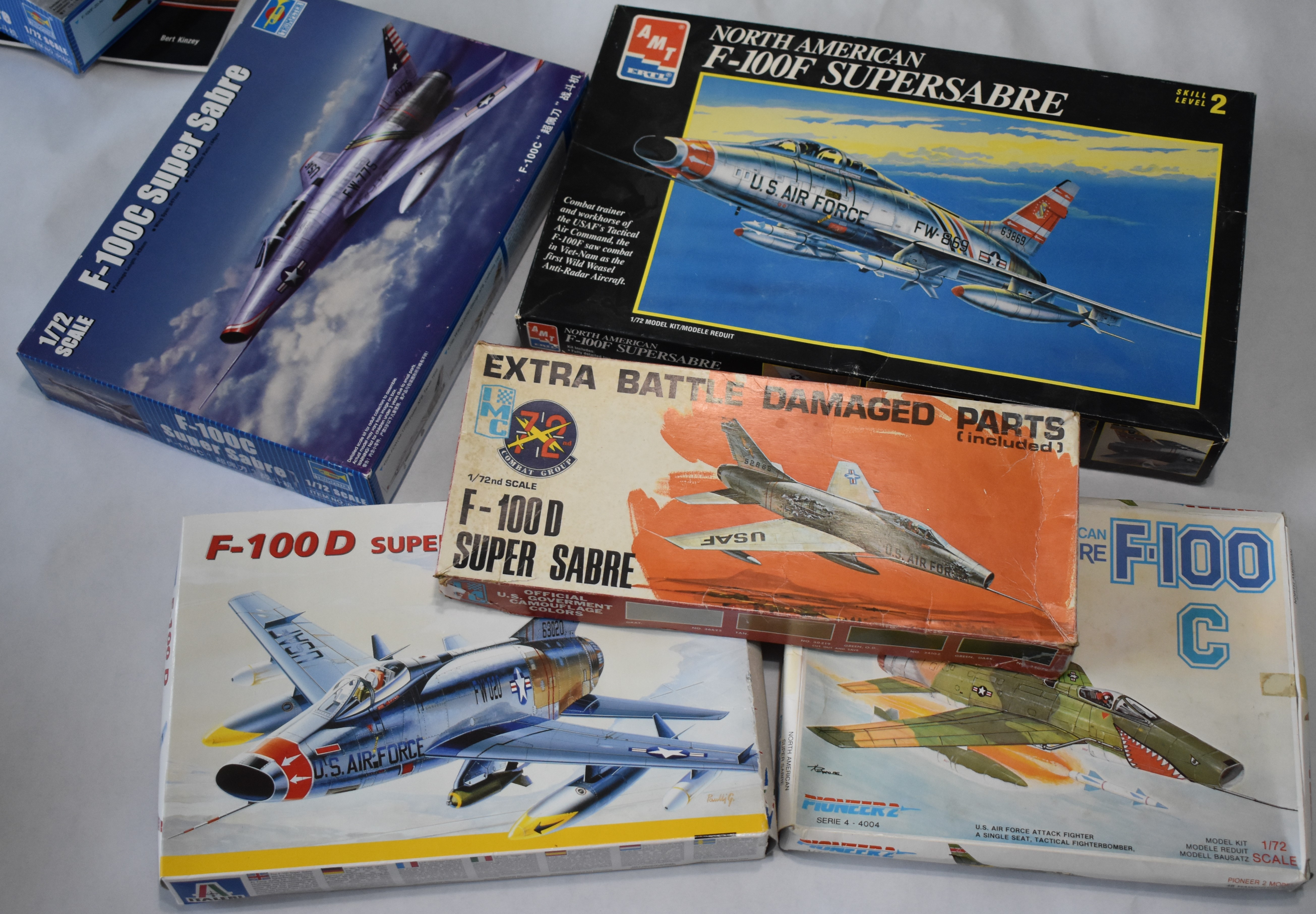 1:72 F-100 SUPER SABER KIT KLASH, OR MORE REASONS WHY YOU CAN’T TRUST SCALE DRAWINGS
1:72 F-100 SUPER SABER KIT KLASH, OR MORE REASONS WHY YOU CAN’T TRUST SCALE DRAWINGS
VEHICLE I-D: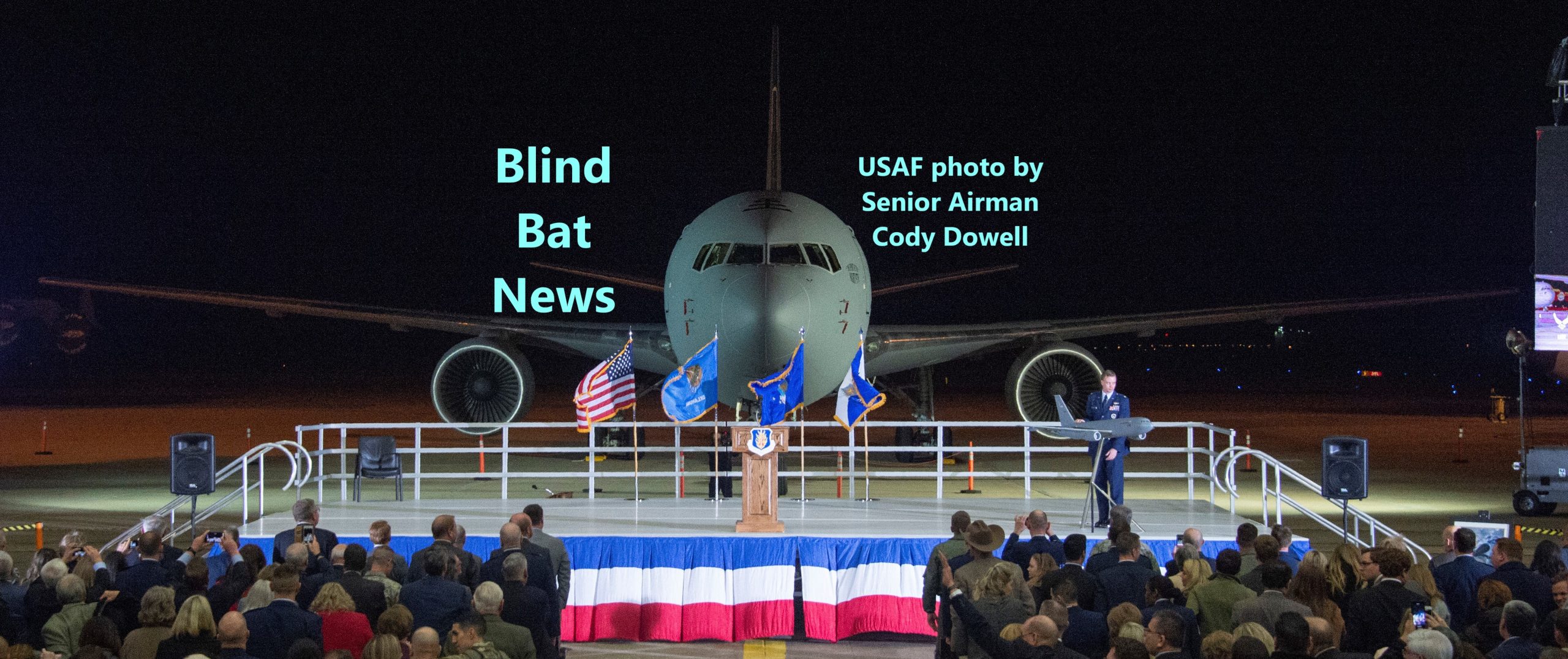 NEW KC-46A PEGASUS (Boeing 767)
NEW KC-46A PEGASUS (Boeing 767)
As far as I’m aware I’ve collected every North American F-100 Super Saber (I prefer the U.S. English spelling versus the Queen’s English spelling Sabre [for some unknown reason preferred by North American]) kit in 1/72 scale, I feel confident I can honestly direct you as to which F-100 kit to spend your hard earned cash on (please don’t make the Too Big to Jail banks rich by using credit).
I also have several books with scale drawings, and once again the ‘authoritative’ drawings themselves don’t match-up.
Detail & Scale Number 4 (1980) uses drawings by Rockwell/Ed Moore/Terry Smith. Detail & Scale Volume 33 (1989) uses drawings by Dana Bell and Terry Smith. Bunrin Do’s Famous Airplanes of the World Number 22 (May 1990) uses drawings that look like 1:72 but no scale is given.
Revell: According to Detail & Scale, this kit first came out in the 1950s and is a piece-o-crap (photos confirm this), it’s much larger than 1:72 scale. It’s supposed to represent a ‘A/C’ version of the F-100. According to Detail & Scale-33 it was last issued in 1987.
Detail & Scale-33 also talks about other ‘1:72’ scale F-100 kits issued by different companies in the 1960s-70s, apparently all actually being scales that are not 1:72.
IMC/Lindberg: According to Scalemates, the IMC kit was the first 1:72 scale Super Saber, out in 1965. Lindberg currently issues it. IMC marketed it as a ‘D’ version yet it has the wing of a ‘A/C’ version (Lindberg wisely dropped the reference to the ‘D’ version). The surface detailing is spurious. Detail & Scale-4 doesn’t mention it, and Detail & Scale-33 simply calls the kit a “gimmick with battle damaged parts”. I was surprised to find the wing, elevators and canopy matched dimension and shape of the Ed Moore and Terry Smith drawings! The vertical tail is too skinny, tall, and set too far back on the fuselage. The fuselage is a little long at the ass-end. The extra long external fuel tanks are too fat and the fins are grossly over-sized. You get separately molded air intake mouth and exhaust/afterburner butt-hole (this is the part that makes the fuselage too long). No weapons come with the kit. Compared to the Dana Bell drawings the fuselage and wing measures out the same as the previous drawings, but the elevators are narrower in span. The same can be said about the Bunrin Do drawings.
Hasegawa/Frog: According to Scalemates, the Hasegawa kit was issued first by Frog in 1970, then Hasegawa in 1971. According to the reviewers in Detail & Scale, it’s accurate shape-wise, but represents the F-100D before all the field mods were applied by the USAF, so it can’t accurately represent a service aircraft. Never-the-less Hasegawa continues to re-issue the thing, and people continue paying too much for it. Compared to the Ed Moore/Terry Smith drawings the fuselage, wing and elevators are a close match. The one piece canopy/windshield is smaller than in the drawings. Compared to the Dana Bell drawings the wing/elevators have too great a sweep-back. You get separately molded air intake mouth and exhaust/afterburner butt-hole, but the fuselage is too long at the air intake and afterburner. The canopy is even smaller compared to Dana Bell drawings. According to the Bunrin Do drawings the wing is very slightly narrower in chord, but good in span. The elevators have too great a sweep-back. The fuselage is too short and too skinny, the canopy is still small. The old kit comes with two styles of external fuel tanks, but not the extra long ones, plus what looks like napalm bombs and Bullpup missiles.
ESCI/AMT-Ertl: Scalemates says this kit first came out in 1982. Reviewers in Detail & Scale-33 praise the kit for being the most accurate F-100D at that time (yes, better than Hasegawa). ESCI was also the first to release a two seat ‘F’ version. It has detailed landing gear, extra long external fuel tanks, separately molded intake mouth, two styles of IFR probes and two styles of after burners. The only weapons are Bullpup and Sidewinder missiles. The wing is a close match to the Moore/Smith drawings, but the elevators are too narrow in span. The fuselage is slightly long at the mouth, the vertical tail is too tall. The canopy/windshield (molded as one) is the closest to matching these drawings. The wing is also a close match to the Bell drawings, but the elevator is not only too short in span, the sweep-back is too great. The fuselage is even longer, yet the tail is only slightly taller. The canopy looks good, but the windshield area looks small. Going by the Bunrin Do drawings the wing is just slightly narrower in span, the elevators match the shape and sweep but are slightly undersized in overall dimension. The fuselage is shorter and narrower, yet the tail matches the height of the drawing. The canopy/windshield looks like a good match.
Click the pics to make bigger:
Pioneer-PM: This monstrosity was unleashed in the early 1990s by British empire company Pioneer. It’s made by a company called PM, based in the NATO country of Turkey. The air intake mouth is molded as part of the fuselage halves. It’s marketed as a ‘C’ version but has the wing of the ‘D’ version. It comes with extra long fuel tanks, Bullpup missiles, blobs with fins that’re supposed to be bombs and an IFR probe that’s missing the receptacle end. Oddly the wing and elevators are a close match with the Detail & Scale drawings, yet the fuselage is too small in overall size (as is the canopy/windshield). Bunrin Do drawings show the wing to be slightly smaller in overall dimension, the elevators having too great a sweep-back, and the fuselage is even smaller, so small you’d think it was a different scale.
Italeri/Revell Germany/Tamiya/Academy: Time to set things straight. This kit is not a re-box of the ESCI kit, it is a re-tooled/so-called improved version of the ESCI kit, first coming out in 1998. The surface details, and the wheel well/air brake well details, are exactly the same. The sprue layout is different. The external fuel tanks are much shorter than the ESCI tanks. You get optional IFR probes and afterburners. For weapons you get two ‘dumb’ iron bombs and two rocket pods. For some odd reason Italeri added a spurious frame to the canopy, about two thirds of the way back on the canopy, rendering it useless. The most noticeable change (besides the canopy guffaw) Italeri made was to the length of the fuselage, which now matches the Moore/Smith drawings. The tail is still too tall. The wing is slightly shorter in span to the Moore/Smith drawings, but the elevators are a close match (the opposite of the ESCI kit). Compared to the Bell drawings the wing is a better match, still slightly short in span. The elevators match the shape but are also slightly short in span. Interestingly the fuselage is too long for the Bell drawings, at the mouth, and the tail is still slightly too tall. For the Bunrin Do drawings the wing is too short in span, slightly narrow in chord. The elevators match. The fuselage is too short, yet the tail matches the height of the drawing. Revell AG (Germany) re-boxed the kit at the same time Italeri first issued it. Beware, Tamiya re-boxed the kit starting in 2001, and I’ve seen it command prices over $20 U.S. (just because it has Tamiya’s name on the box), Academy re-boxed the kit in 2017 also commanding a high price for it, don’t do it!
Trumpeter: And the winner is! Starting in 2009 Trumpeter issued what every Super Saber builder wanted; super detailed kits in the ‘C’, ‘D’ and ‘F’ variants. The kit comes with separate flaps and slats for the wing. Optional IFR probes. Detailed exhaust/afterburner section (only the early non-f-102 style of afterburner). Air intake trunking (but the mouth is molded as part of the fuselage halves and is narrower than the other kits). Optional factory air brake or field modified air brake. Optional extended or folded nose pitot. Boarding ladder. Highly detailed interior parts. The instructions make it look like the canopy suffers from the now ubiquitous ‘parting line’ syndrome that most Asian kits are infected with, but the canopies that came with my kits (the ‘C’ and ‘F’ versions) were free of this parting line. For the ‘C’ version the instructions want you to attach the tail hook which, according to my references, the ‘C’ version did not have a tail hook. The weapons load is extremely limited (as is with all the kits reviewed); Sidewinders and ECM pods depending on the kit version. The external tanks are about the size of the Italeri kit’s. Detail & Scale-4’s drawings show the wing to be much too short in span, the elevators are a match. The fuselage is almost a direct hit with the tail being slightly too tall. The canopy and separately molded windshield both look slightly small. Compared to the Bell drawings, in Detail & Scale-33, the fuselage is almost a direct hit with the nose being too long. The canopy looks good, but the windshield still looks small. The wing is too short in span and slightly narrow in chord. The elevators look like a match. With the Bunrin Do drawings the wing is good span-wise but way too narrow in chord. The elevators are too long in span. The fuselage and tail are too short. The canopy is slightly small, but the windshield looks good.
Conclusion: Avoid the odd Pioneer F-100, with its 1:72 scale wings and 1:80(?) scale fuselage. If you want something cheap that you can assemble and paint in less than a day, then hang from the ceiling, then Lindberg’s re-issue of the ancient IMC kit is for you (sometimes you can find the Hasegawa kit for less cost than the IMC/Lindberg kit so go for that then). The old ESCI kit is still good-to-go for building something you want to proudly display on the shelf, but don’t waste your time and money on aftermarket detailing sets. If you want the most detailed F-100 kit available (and you were thinking of buying an ESCI kit plus detailing sets) then it’s the Trumpeter kit hands down, no need to buy aftermarket detail sets (but you can if you’re obsessive and rich ). Even with its flaws the Trumpeter kit is still better than all the other older kits available.
P.S. The most needed aftermarket item for these kits is a good variety weapons set.
Gate Guards: F-100 Super Sabre
1/600 MOSKVA: AURORA VS AIRFIX
BLACKLIGHT REVELL DEAL’S WHEELS
HEINKEL HE-51: HASEGAWA VS. ICM
GEORGIA’S MUSEUM OF AVIATION MODEL SHOW, 2017
RED DEVIL AWARDS 2017, ARE THEY REAL OR ARE THEY MODELS?
GROCERY STORE USES MODEL PLANES TO ATTRACT CUSTOMERS!
IDAHO CAT CAUGHT INSTRUCTING HUMAN HOW TO BUILD CORVETTE!
1:48 F-105G WILD WEASEL SHOWDOWN, HOBBYBOSS VS MONOGRAM
1:72 SHOCK & AWE LOCKHEED F-104 STARFIGHTER, OR, WHY YOU CAN’T TRUST SCALE DRAWINGS!
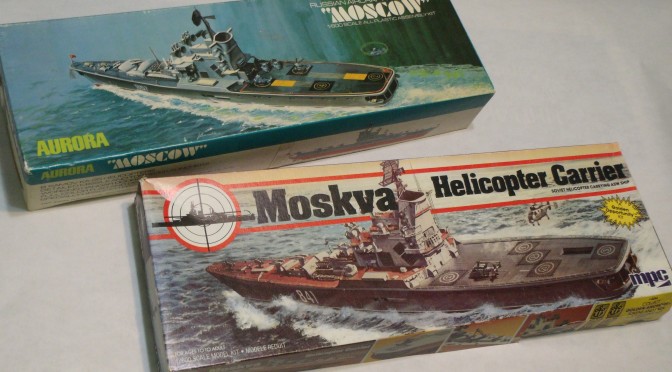
One of the first ship kits I built was the 1:600 scale Aurora Moscow helicopter anti-submarine ship (not to be confused with the Moskva of the Atlant class of missile cruisers, aka Project 1164). I also built the Airfix version, and there are differences.
Back then it was the final two decades of the Cold War (unbeknownst to both NATO and Warsaw Pact) and we average kit builders in the United States didn’t have access to reliable information on Warsaw Pact vehicles. Most publications in English would only say that what we now know was Project 1123 Kondor couldn’t handle rough seas, and that production was halted after only two ships were launched. I always doubted such NATO propaganda because if the ships were so bad why were they in use until the mid-1990s?
Today we do have access to reliable info (including Kagero Top Drawings #55 book, with detailed scale drawings of things like missile launchers, for those of us who read English), and we have at least one aftermarket detailing set for the 1:600 scale Moskva. I spent a lot of money on a Russian magazine supplement before learning about the Kagero book. I also got a hold of the photo etched set #618 by White Ensign.
The Aurora Moscow was first issued in 1969, and for some reason last issued in 1972. Airfix issued their Moskva in 1973, and as far as I know last issued it in the late 1990s. In the early 1980s it was issued in the U.S. under the MPC brand.
The Aurora and Airfix hulls are just short of 13 inches (33cm) long, the Aurora being slightly shorter than Airfix. The Aurora hull is also taller and skinnier than the Airfix hull. The anchors are molded onto the Aurora hull and both kits have different shaped hull openings and portholes.
Both kits have chunky plastic for the radar antennae. Both kits do not come with missiles for the missile launchers. Both kits do not have the massive retractable sonar dome located towards the front of the bottom of the hull. It was this massive dome that was probably the reason the tall ship reportedly nose dived into the water during rough seas. Apparently NATO was unaware of this dome during the Cold War, or for some reason it was never mentioned in publications made available to the general public.
The Airfix Kamov helicopters are molded in two halves and don’t look good. The Aurora helicopters are molded in one piece, they look good but not quite like Kamovs (more like Kamovs than Airfix). The plus with the Aurora kit is you get optional retracted/folded rotor blades. The Aurora deck is one piece with more detailing than Airfix, and even has optional position hanger doors and space in the superstructure/funnel (molded in two pieces) area. The Airfix deck is in three pieces, it has optional position hanger doors but the space in the superstructure/funnel (molded in three pieces) is blanked off. The Airfix helicopter deck has recessed spaces to represent elevators.
The big open ass, I mean aft end, I mean stern of the ship is plane Jane in the Aurora kit, with two life boats. There’s some kind of blocky details in the Airfix kit. Aurora gives you davits to hang the life boats on, while Airfix gives you upside down ‘U’s to set them on. The propellers, I mean screws are different in shape and size between the two kits.
The ship has two large cranes, Aurora uses chunks of plastic to represent them while Airfix gives you a better looking multi-part system.
Click on the pics to make them bigger:
The White Ensign photo etched set has thin brass parts for the radars, railings, davits, cranes, hanger doors, missile launcher detailing, much better details for the ass end, ship name plates (Moscow & Leningrad) and parts for the Airfix helicopters (including tini-tiny landing gear parts which’l probably bend under the weight of the plastic). A major problem with White Ensign’s instructions is that they leave out where to use the differently shaped hand rails. Also, you get PE rotor blades in the extended position, but not retracted.
If you love 1:600 scale ships the best way to get a good looking and close to accurate Moskva/Leningrád is to kit bash the Airfix and Aurora kits, use the White Ensign Models PE set, and scratch build missiles, as well as the sonar domes under the hull.
Note: Research is also key to making as accurate a Project 1123 as you can. The ships had numerous different hull numbers and even different ‘paint jobs’ over the decades. You’ll need to find color photographs of a specific hull number, especially overhead views which’l reveal what color/colors the decks were painted.
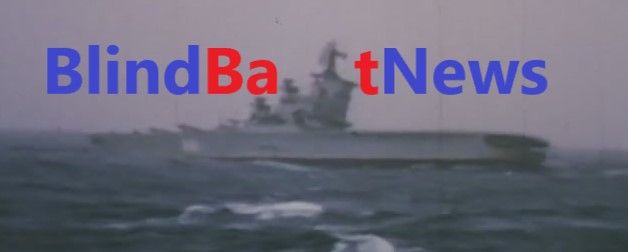 MOSKVA CLASS SUBMARINE HUNTERS, STOP CALLING THEM AIRCRAFT CARRIERS!
MOSKVA CLASS SUBMARINE HUNTERS, STOP CALLING THEM AIRCRAFT CARRIERS!
1:600 USS IOWA CLASS KITS: AURORA, MONOGRAM, OTAKI, REVELL. AN APPEAL TO AIRFIX!
1:72 HEINKEL HE-51: HASEGAWA VS. ICM